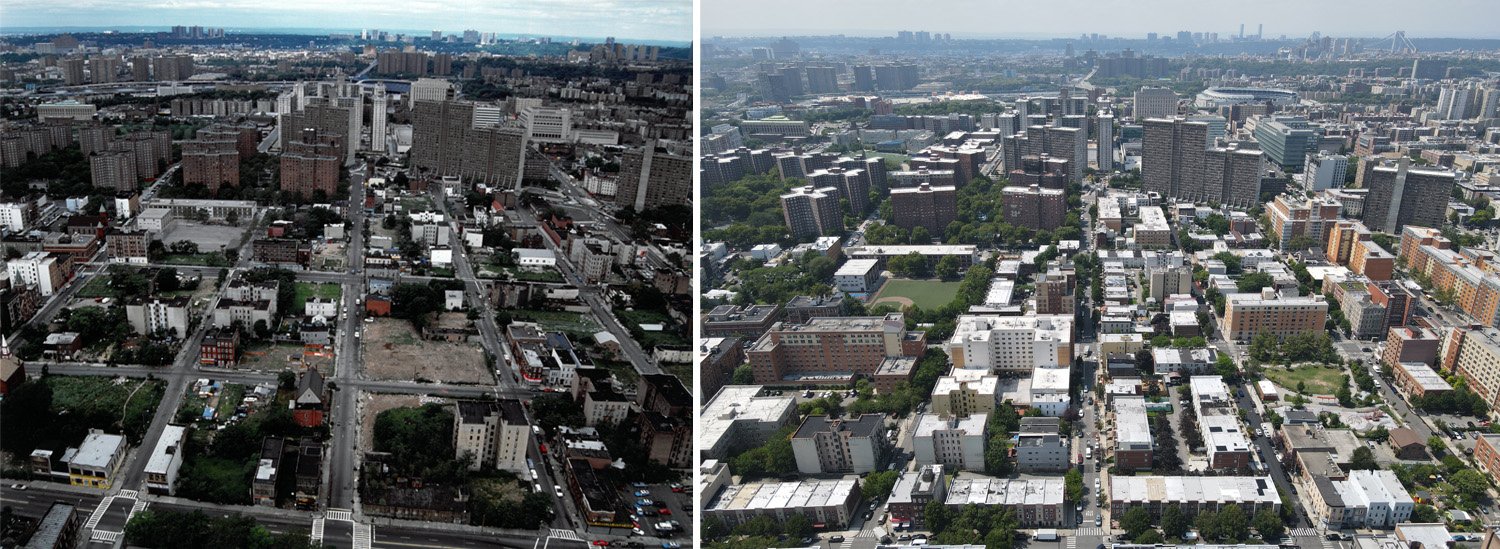Community-Driven Development in New York City: The Melrose Commons Master Plan
30 years later, the revitalization project in this South Bronx neighborhood provides a framework for inclusive design and housing production.
Introduction
This year marks the 30th anniversary of the passage of the Melrose Commons Master Plan, which sparked dramatic investment in and reimagination of the South Bronx and set a new standard for community-oriented design and development. Born out of a central goal of limiting displacement, Melrose Commons connects individuals and families with affordable, stable housing that they can be proud to call home.
Developed by Nos Quedamos (We Stay) and Magnusson Architecture and Planning (MAP), the Melrose Commons Master Plan has guided the transformation of this 33-block area. The work gave residents a voice in the future of their neighborhood. Over the years, developers partnering with community groups and respected neighborhood organizations, replaced the vacant and distressed properties identified in the plan with a mix of community, commercial and residential uses adding vibrancy to the streetscape and opportunities to access safe, high-quality, affordable housing. MAP has been involved in 15 of the developments, designing over 1,500 new homes within the community. The overall transformation is striking.
View North, 1995 (left), 2024 (right)
View East, 1995 (left), 2024 (right)
View South, 1995 (left), 2024 (right)
View West, 1995 (left), 2024 (right)
Now, amid a growing affordable housing crisis and disagreement about how to fix it, the lessons remain as salient as ever – and can serve as an example of how essential affordable housing investment can be for neighborhoods across the City’s five boroughs.
Project Overview
By the early 1990s, following the decades of divestment, including widespread fires of the 1970’s the South Bronx was left with large swaths of vacant property and needed significant investment to improve housing access and infrastructure. For the Melrose Commons neighborhood, the city had developed an initial urban renewal plan that would have required the demolition of properties across the neighborhood and the development of a market-rate suburban-scale community in its place. Created without any input from local residents, this plan would have resulted in the displacement of those who had lived there for generations. After hearing of this, community members protested and demanded they play a central role in any new development framework.
Early meeting of community members
In response, residents formed Comité Nos Quedamos – a unified voice to articulate the community’s concerns regarding displacement and disruption in the neighborhood and their aspirations for the community. As part of that process, they tapped MAP to collaborate on a new approach which was centered around residents and their needs. The groups ultimately won city approval in July 1994 for a new, community-driven redevelopment plan: the Melrose Commons Master Plan.
Melrose Commons Early Concept Plan
Melrose Commons Plan (updated in 2004)
This partnership is an excellent example of collaboration to create housing that limits displacement and uplifts both residents and the surrounding community – and shows how that collaboration can sow the seeds for housing access for generations of residents to come. In the years since, MAP has designed close to 1,500 new affordable homes through the plan. Parents have watched their kids grow up in these buildings, seniors have been able to age in their homes and residents have had access to affordable housing thanks to the commitment to community-oriented housing creation made 30 years ago.
New park created as part of the Melrose Commons Plan with MAP designed La Terraza
MAP has gone on to specialize in affordable and supportive housing design, creating over 14,000 units of housing in over 100 developments in the greater New York area. The firm’s approach prioritizes inclusivity, quality, and health, and begins with the understanding that everyone deserves beautiful, safe, supportive communities. This philosophy has led to decades of experience navigating the city’s land use system to create affordable housing that is tailored to the needs and preferences of its surrounding neighborhood.
The Current Landscape
There are still communities in New York City that need investment and revitalization strategies, as well as many others in the region and beyond. The city, however, is a vastly different place in 2024, and is now facing the worst housing crunch in the past half-century. At it’s most basic, this is a problem of inclusivity, and our willingness to build the housing people need in order to stay. In 2023, the city’s vacancy rate dropped to 1.4%, the lowest it has been since 1968. City Hall has acknowledged that, without significant public investments in new construction and housing preservation, housing insecurity will continue to grow while squeezing middle- and low-income New Yorkers out of the city.
To keep up with demand, the Regional Plan Association projects New York City will need 817,600 new units of housing by 2032. Yet, the city completed just 11,300 residential units in 2023, the New York Building Congress reported.
It is important that all neighborhoods invest in public infrastructure that supports and provides for all New Yorkers. It is important too that we have the range of housing options that different people need, the very same people the City needs to thrive. Key to this is the development of affordable housing, which has proven to have a generational impact on the financial, physical and mental health of residents. 30 years on, the core tenets of The Melrose Common Plan are as relevant as ever.
Core Tenets of the Melrose Commons Plan
The Melrose Commons Master Plan framework contains eight major goals for a community-oriented redevelopment plan:
The plan should cause no involuntary displacement of the existing community.
The plan should permit a mixed income community to develop and create a variety of ownership and rental housing.
The plan must provide affordable housing at densities appropriate to an urban community.
The plan should utilize architectural design guidelines that maximize public investment by creating a visually desirable, urban environment that will encourage development.
The plan should promote physical development that is both environmentally conscious and sustainable.
The proposed open space should be distributed into a system that responds to the community’s concerns of program and security.
The plan should respect the street pattern and movement patterns within the community.
The plan should provide for an appropriate distribution of commercial space and services and enable community residents and businesses to increase their earnings potential and expand their economic opportunities.
Listening to the Community
The main lesson from the community meetings, to establishing and crafting the plan, to developing the neighborhood sites is that design matters, a lot. Quality of life measures like dignified lobbies, large apartment windows and laundry rooms that opened onto play areas in rear yards made for much nicer living environments. It was a focus on resident happiness and well-being that has remained essential to MAP’s design approach and has carried through to all the firm’s affordable housing developments like the award-winning St. Augustine Terrace and MLK Plaza (both located in the Bronx, but outside of Melrose Commons).
La Puerta de Vitalidad with community room and laundry that open onto landscaped yard
St. Augustine Terrace
MLK Plaza
It was clear, too, that building design mattered to those who didn’t live there. Those who would pass the building everyday wanted to appreciate these buildings, and enjoy the street level activity and the goods and services that ground floor commercial or community spaces offered.
Contextual design was important, so MAP looked for ideas within the community, borrowing familiar materials like brick and cast stone from nearby Deco era buildings. While many buildings proposed in the plan were necessarily taller than those around them, breaking the mass was another move to reduce bulk. By separating the exterior into smaller volumes, through slight setbacks, material or color changes, the designs avoid a monolithic feel and achieve a more human-scaled presence along the streetscape. Making both aesthetic and programmatic contributions to their neighborhood, these buildings were viewed as assets and gained them acceptance not always afforded to new developments. This is directly attributable to a process of engagement that balanced priorities and was at its heart always community-minded.
The Aurora
Orion, before and after
Building Sustainably
The Melrose Commons plan was designed with sustainability in mind, using the best technologies available at the time to ensure new buildings provided reduced utility bills. In 2010, Melrose Commons even became the first project in New York State to achieve Stage II LEED-ND Silver Certification. While the decision to pursue an “environmentally conscious and sustainable” design as a core tenet of the Melrose Commons Master Plan was novel at the time, it has served an important function. By successfully incorporating these concepts into the design of the neighborhood, the Melrose Commons neighborhood was an “early adopter” of concepts and technologies that are now common – and in some cases, legally required – in development.
La Puerta de Vitalidad
Melrose Site C - Family Building
Since the passage of the Melrose Commons Master Plan, City and State funding agencies have adopted stricter building standards for affordable housing, designed to protect public health and reduce emissions. In fact, due in large part to the requirements, affordable housing buildings are some of the most efficient in the city – the prioritization of sustainability throughout design and development is mandated across all new construction.
By demonstrating the technical and economic feasibility of incorporating sustainable practices into the creation of desirable affordable housing in Melrose Commons and communities like it, MAP’s designs have helped to drive this approach forward and lay the groundwork for today’s sustainable building standards in New York.
Initial design for Cornerstone B2
Cornerstone B2, initial design in Context
MAP is currently designing affordable housing for the last of the originally designated Melrose Commons sites - the firm’s 50th development in the Bronx - a site referred to as Cornerstone B2. The initial designs here are currently being updated to reflect new possibilities for additional density through City of Yes. The new building will include more advanced sustainability measures, constructions methods and building systems, reflecting the design approach that MAP has utilized in other recent projects (outside of Melrose) like Highbridge and Carmen Villegas Apartments.
Highbridge
With the passage of Local Law 97 (the city’s law that caps greenhouse emissions and energy consumption and requires building owners to implement energy savings measures), the incorporation of more advanced sustainability practices is standard in MAP’s rehabilitation projects too. This is timely as the earlier Melrose Commons affordable buildings enter maintenance and retrofitting phases of their lifecycles.
Long-Term Success and Recognition
Over its 30-year history, the Melrose Commons Master Plan has garnered numerous awards, including:
2012 Charter Awards (Congress for the New Urbanism)
Award of Excellence: Honorable Mention for Neighborhood, District and Corridor2009 MASterwork Awards: Honorable Mention for Best Neighborhood Catalyst
2005 AIANYC Housing Awards Program: Design Award
1998 NYC Centennial Exhibition: Museum of the City of New York
1996 Civics Lessons: Recent New York Public Architecture
1994 ADPSR Project Award: Socially Responsible Work
Implications for NYC’s Current Land Use Environment
The commitment to community-oriented development was vital to the success of the Melrose Commons Master Plan. Putting first the considerations, design preferences and needs of residents laid the foundation for the success of this project. Over the years, this approach has, in many respects, become more standard for development within the city. Still, the eight tenets outlined above can be a useful framework to align residents and stakeholders that may be skeptical or opposed to new development proposals – a necessity given the housing crisis.
As ideas like City of Yes for Housing move forward, partnerships with community organizations that have deep roots could help facilitate buy-in and make meaningful inroads in solving our affordable housing crisis. The city is at an inflection point, one which requires consensus-building, thoughtful listening and stakeholders pulling together for the common good. The future of our city depends on it.
Photos: Andrea Brizzi, Seong Kwon, USGBC, Miguel de Guzman/Imagen Subliminal, MAP Archives



















